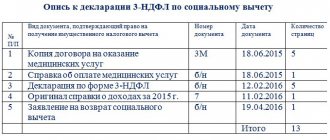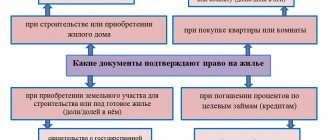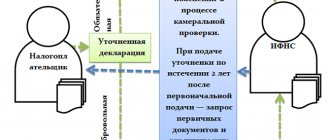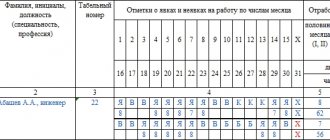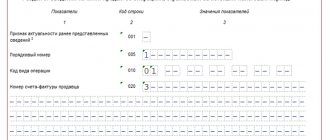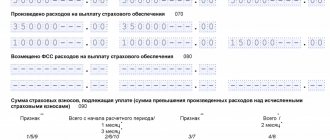The VAT return reflects all information related to the calculation of value added tax. There are sections in the VAT return where you need to fill out the VAT amount for crediting and deducting. There are also sections for tax agents to reflect VAT on exports and imports, as well as transactions that are not subject to taxation.
In order to ensure that tax inspectors do not raid the company for an inspection, it is necessary to fill out the VAT return correctly.
VAT return structure
The VAT return consists of twelve sections. When filling out a VAT return, there is no need to complete all sections. The required sections to be filled out are the title page and the first section, the remaining sections are filled out as necessary, it all depends on what VAT transactions were carried out at the enterprise in the reporting period in which the VAT return is submitted. Let's look at each section separately in table form:
| Section title | Information that is reflected in the section |
| Title page | Information about the enterprise is indicated, namely: INN, KPP, Full name, OKVED code, contact telephone number, and the tax period must also be indicated. |
| Section No. 1 | Reflects the amount of tax that is payable to the budget for the taxpayer |
| Section No. 2 | The amount of tax that is payable to the budget according to the tax agent is reflected. |
| Section No. 3 | Calculation of the amount of tax that must be paid to the budget for those transactions that are subject to taxation |
| Section No. 4 | Calculate the amount of tax that falls under the 0% rate with supporting documents |
| Section No. 5 | Calculation of the amount of tax deduction for sold goods, works, services, at a rate of 0% based on supporting documents |
| Section No. 6 | Calculation of the amount of tax on the sale of goods, works, services at a rate of 0%, but not documented |
| Section No. 7 | Transactions that are not subject to taxation or are exempt from VAT are reflected. |
| Section No. 8 | Displays information from the purchase book that is reflected for the current reporting period |
| Section No. 9 | Reflects data from the sales book that is reflected for the reporting period |
| Section No. 10 | Reflects data from the book of issued invoices for transactions that are associated with persons who provide forwarding services, developers and commission agents and agents working for the benefit of third parties |
| Section No. 11 | Reflects data from the book of received invoices for transactions that are associated with persons who provide forwarding services, developers and commission agents and agents working for the benefit of third parties |
| Section No. 12 | availability of invoices with allocated VAT presented to counterparties. |
What is section 3 of the VAT return about?
Section 3 is the main part of the VAT return where taxpayers must calculate the tax due or refundable. The algorithm for filling out the lines in section 3 of the VAT return is as follows:
- Lines 010–040 - displays the amount of revenue from sales (based on shipment), which is taxed at the current tax and estimated interest rates.
- Line 050 is required when selling an organization in the form of a complex of accounting assets.
- Line 060 is intended to be filled out by manufacturing and construction companies that carry out construction and installation work for their needs.
- Line 070 “Tax base” displays the funds received for upcoming deliveries. Value added tax is calculated at a rate of 20 or 10% depending on the type of goods, works, and services. If the sale is made within 5 days after the advance payment is made, then the amount should not be indicated as an advance payment.
- Lines 080–100 must contain the amount of tax to be restored.
- Lines 110–118 indicate the VAT amounts.
- Lines 120–190 contain VAT to be deducted.
- Lines 200–210 reflect VAT payable or refundable for the tax period.
Section 3 contains the amounts of value added tax, which is subject to restoration for tax accounting in accordance with clause 3 of Art. 170 Tax Code of the Russian Federation. This applies to amounts that were previously declared in the form of tax deductions on preferential terms (the company applies a special regime that exempts from VAT).
How to submit a VAT return
The VAT return is submitted electronically; for this, the taxpayer must register in the system for providing tax and accounting information. After which the taxpayer will be provided with an electronic signature, with which he will be able to sign documents and send them to the tax office.
The date of reporting is considered to be the date of dispatch, where the taxpayer receives a response about the fact of its acceptance. After a desk audit, the taxpayer receives an acceptance response in the form of a receipt for acceptance of the reporting or a refusal to accept the reporting in the form of a notice of refusal. If there was a refusal, then it is necessary to adjust the previously sent declaration and send it to the tax office again.
Important!!! If, when sending reports, there are technical failures in the system or operator service, then there is no reason for the accountant to send reports untimely, but this will need to be proven.
Filing reports on paper is permitted only to tax agents who are not VAT payers or are exempt from paying it.
VAT tax agent: general information about the declaration
Organizations that, based on the results of their activities, will be recognized as tax agents are required to submit a declaration by the 25th day of the month following the reporting quarter. Moreover, the filing of the declaration, after recent innovations, should be carried out only in electronic form, with the exception of those cases where the reporting person is not recognized as a VAT payer (has an exemption), but due to the prevailing circumstances has acquired the status of a VAT tax agent. Such persons may submit a declaration on paper. ATTENTION! In both cases, the declaration is submitted to the tax office to which the organization belongs territorially.
The declaration form was approved by order of the Federal Tax Service dated October 29, 2014 No. ММВ-7-3/ [email protected] and has been used since 2015.
Line 070 in the VAT return
The VAT return consists of 12 sections, and almost every section has line 070.
But in each section this line has its own specifics and is filled out according to the appropriate rules. When filling out a VAT return, it is not necessary to fill out all sections; there are sections that do not require completion. But section No. 3 is always filled out and under any circumstances.
Line 070 of Section 3 reflects the amount of VAT calculated on advances paid by customers. Then, at the time of sale of goods (works, services), the advance payment is offset and this VAT is claimed for deduction.
Before entering data on advance VAT in line 070, the buyer must:
| The seller must attribute the advance to future sales, subject to VAT at a rate of 10 or 18% | To do this, you need to do the following: Deduct VAT from the advance received on the day it is received; Determine the amount of VAT using the calculation method; Issue an invoice to the buyer within five days from the date of receipt; The advance payment and the corresponding tax amount are reflected in the sales book and in line 070 of section 3 of the VAT return |
| Sales of goods, works or services are taxed at a rate of 0% or are generally exempt from tax. | In this case, VAT is not charged on the advance payment, and no VAT invoice is issued. And the data on the advance received and VAT invoiced is not reflected in line 070. |
How to check the correctness of filling out the VAT Declaration when maintaining complex VAT accounting
Today, on the Internet and even in specialized magazines, you can easily find information on how to prepare a VAT Declaration in the 1C: Accounting 8, edition 3.0 program.
Also, many resources have published articles about the organization of VAT accounting in this program and about the existing VAT accounting checks in the program and ways to find errors. Therefore, in this article we will not once again describe in detail the principles of organizing VAT accounting in 1C: Accounting 8; we will only recall the main points:
- For VAT accounting, the program uses internal tables, which in 1C terms are called “Accumulation Registers”. These tables contain much more information than in the postings on account 19, which allows you to reflect in the program
- When posting documents, the program first performs movements in the registers, and based on the registers it generates postings for accounts 19 and 68.02;
- VAT reporting is generated ONLY according to register data. Therefore, if the user enters any manual entries into VAT accounts without reflecting them in the registers, these adjustments will not be reflected in the reporting.
- To check the correctness of VAT accounting (including the correspondence of data in registers and transactions), there are built-in reports - Express check of accounting, VAT accounting analysis.
However, the average accountant user is much more accustomed to working with “standard” accounting reports - Balance Sheet, Account Analysis.
Therefore, it is natural that the accountant wants to compare the data in these reports with the data in the Declaration - in other words, check the VAT Declaration for turnover. And if the organization has simple VAT accounting - there is no separate accounting, no import/export, then the task of reconciling the Declaration with accounting is quite simple.
But if some more complex situations arise in VAT accounting, users already have problems comparing data in accounting and data in the Declaration.
This article is intended to help accountants perform a “self-check” of filling out the VAT Return in the program. Thanks to this article, users will be able to:
- independently check the correctness of filling out the VAT Declaration and compliance of the data in it with accounting data;
- identify places where the data in the program registers diverges from the data in accounting.
Initial data
So, for example, let’s take an organization that is engaged in wholesale trade. The organization purchases goods both on the domestic market and through import. Goods can be sold at rates of 18% and 0%. At the same time, the organization maintains separate VAT accounting.
In the first quarter of 2021, the following transactions were recorded:
- Advances were issued to suppliers, invoices for advances were generated;
- Received advances from customers, generated invoices for advances;
- Goods were purchased for activities subject to 18% VAT;
- Goods were purchased for activities subject to 0% VAT;
- Imported goods were purchased, customs VAT was registered;
- Input VAT has been registered for the services of third-party organizations, which should be distributed to operations at 18% and 0%;
- A fixed asset was purchased at a VAT rate of 18%, the tax amount must be distributed among operations at different VAT rates;
- Goods were sold at a VAT rate of 18%;
- Goods were sold for activities subject to 0% VAT;
- Some of the goods on which VAT at a rate of 18% was previously accepted for deduction were sold at a rate of 0% - the restoration of VAT accepted for deduction is reflected;
- The shipment without transfer of ownership and then the sale of the shipped goods are reflected;
- Confirmed 0% rate for sales;
- Regular VAT operations were completed - sales and purchase book entries were generated, VAT was distributed for transactions at 18% and 0%, purchase book entries were prepared for the 0% rate.
Checking reporting data
After completing all regulatory VAT operations, the VAT Declaration is completed with us as follows:
Lines 010-100:
Lines 120-210:
Let's start checking the Declaration.
2.Check Section 4
To begin with, since we had sales at a 0% rate, let’s check the completion of Section 4 of the Declaration:
To do this, you need to compare the data in Section 4 with the turnover on account 19 according to the VAT accounting method “Blocked until confirmed 0%” in correspondence with account 68.02. To do this, we will generate an “Account Analysis” report for account 19, setting it to select by accounting method:
The credit turnover on account 68.02 in this report shows us the total amount of tax that “fell” on confirmed sales at a rate of 0%. This amount must coincide with line 120 of Section 4 of the VAT Declaration .
3.Check Section 3
Next, we check Section 3 of the Declaration. The main report that we will use when checking Section 3 of the Declaration is Analysis of Account 68.02. For the 1st quarter of 2021, the report looks like this:
This line shows the amounts from the sale of goods, works, services at a rate of 18% and the amount of tax calculated from such transactions. Therefore, the amount of tax on this line must correspond to the amount of credit turnover on account 68.02 in correspondence with accounts 90.03 and 76.OT (shipments without transfer of ownership):
Line 070 indicates the amount of VAT on advances received from customers in the reporting period. Therefore, to check this amount it is necessary to look at the credit turnover on account 68.02 in correspondence with account 76.AB :
The line should reflect the VAT amounts subject to recovery for various transactions. This line includes the amount of VAT on advances to suppliers credited in the reporting period, as well as the amount of VAT recovered when changing the purpose of use of valuables.
VAT on advances to suppliers is accounted for in account 76.VA, so we check the amount of credited VAT against the credit turnover of account 68.02 in correspondence with account 76.VA. The amounts of restored VAT are reflected in accounting as credit turnover on account 68.02 in correspondence with subaccounts of account 19 :
This line is a clarification to line 080 - the amounts of VAT on advances to suppliers credited in the reporting period are shown separately here:
How to check line 120 of the VAT return if the organization maintains separate accounting for VAT? The line must reflect the amount of tax on purchased goods, works, services, which is subject to deduction in the reporting period.
Therefore, to check the value on this line, it is necessary to subtract the turnover on account 19 from the turnover on the debit of account 68.02 in correspondence with accounts 19.01, 19.02, 19.03, 19.04, 19.07 using the VAT accounting method “Blocked until confirmation of 0%” in correspondence with account 68.
02 (the amount indicated in line 120 of Section 4 of the Declaration).
The line indicates the amount of VAT on advances issued to suppliers in the reporting period. We check the amounts of accrued VAT using the debit turnover of account 68.02 in correspondence with account 76.VA :
Line 150 indicates the amount of VAT paid at customs when importing goods. The value in this line must match the debit turnover on account 68.02 in correspondence with account 19.05 :
The line is filled in with the amounts of VAT that our organization paid when importing goods from the countries of the Customs Union. This line is checked against the debit turnover of account 68.02 in correspondence with account 19.10 :
And finally, line 170 is filled in with VAT amounts on buyer advances received during the reporting period. This value is reflected in accounting as a debit turnover on account 68.02 in correspondence with account 76.AB :
4.Results of the inspection
If we put together all the checks for Section 3 and reflect them in the “Account Analysis” report for account 68.02, we will get this “coloring”:
Based on the results of the audit, we see that all the amounts reflected in the accounting “found” their place in the VAT Declaration.
And each line from the Declaration, in turn, can be deciphered by us from the position of reflecting the data in accounting.
Thus, we are convinced that all operations in the program are reflected correctly, without errors, the data in the registers and transactions match and, therefore, our VAT reporting is correct and reliable.
Summary
To summarize, you can display the methodology for reconciling the Declaration and accounting data in the form of a table:
| № | Declaration line | Accounting data |
| 1 | Line 010, Section 3 | Revolutions Dt 90.03 Kt 68.02 + Revolutions Dt 76.OT Kt 68.02 |
| 2 | Line 070, Section 3 | Speed Dt 76.AV Kt 68.02 |
| 3 | Line 080, Section 3 | Revolutions Dt 19(...) Kt 68.02 + Revolutions Dt 76.VA Kt 68.02 |
| 4 | Line 090, Section 3 | Speed Dt 76.VA Kt 68.02 |
| 5 | Line 120, Section 3 | Speed Dt 68.02 Kt 19(01, 02, 03, 04, 07) |
| 6 | Line 130, Section 3 | Speed Dt 68.02 Kt 76.VA |
| 7 | Line 150, Section 3 | Revolutions Dt 68.02 Kt 19.05 |
| 8 | Line 160, Section 3 | Revolutions Dt 68.02 Kt 19.10 |
| 9 | Line 170, Section 3 | Speed Dt 68.02 Kt 76.AV |
| 10 | Line 120, Section 4 | Turnover Dt 68.02 Kt 19 (according to the accounting method “Blocked until 0% is confirmed”) |
Of course, in the 1C: Accounting program 8, ed. 3.
0 today, a VAT accounting methodology has been implemented, which allows you to reflect even complex and non-standard VAT transactions in the most simple and user-friendly way.
At the same time, the system also contains many checks that help to avoid errors when reflecting transactions. However, unfortunately, everything cannot be foreseen and errors due to human factors can still occur.
The method for checking VAT reporting described in this article will help the user identify the presence of such errors in accounting and understand which sections of VAT accounting need to be double-checked.
In addition, this method does not take much time - after spending literally half an hour, the accountant understands whether everything is correctly reflected in the program regarding VAT or whether he needs to double-check some points and start using tools for detailed analysis and searching for VAT errors.
Source: https://infostart.ru/public/635324/
An example of filling out line 070 in the VAT return in section No. 3
Limited Liability Company "OknaPlast" is engaged in wholesale supplies of plastic windows according to customer orders. Contracts are concluded with the buyer only upon provision of an advance payment in the amount of 10% to 30% of the contractual delivery amount.
In the second quarter of 2021, OknaPlast LLC:
- We sold goods in the amount of 29,688,800 rubles. (including VAT = RUB 4,528,800);
- An advance payment was received in the amount of RUB 14,903,400. (VAT = 14,903,400 rubles × 18 / 118 = 2,273,400 rubles);
- Purchases from a supplier of plastic and other components in the amount of RUB 10,055,960, including VAT = RUB 1,533,960.
Therefore, in the second quarter:
- accrued VAT amounted to RUB 6,802,200. (RUB 4,528,800 + RUB 2,273,400);
- VAT deductible: RUB 1,533,960;
- VAT payable: RUB 6,802,200. – 1,533,960 rub. = 5,268,240 rub.
How to fill out section 2 of the VAT return - features
In 2021, filling out the declaration in this part has not undergone significant changes compared to the previous year. It is necessary, as already noted, to indicate information about all counterparties in respect of which the organization is a tax agent.
IMPORTANT! Information for each counterparty is indicated on a separate page.
Foreign entities, as well as government agencies leasing property, can act as counterparties.
NOTE! If there are several contracts, information about them is reflected on one page, as in the case of the sale of confiscated and ownerless property.
The exception to this group are shipowners who did not manage to carry out registration actions in relation to their vessels within the period established by law (45 days). They must reflect information about each vessel in detail.
It should be noted that if the filling order remains the same, the names of the elements of section 2 have changed slightly. Thus, the innovations affected line 060, which now looks like this: “the amount of VAT that is payable to the budget.” Moreover, this amount should be reflected in conjunction with a certain BCC.
What are the penalties for submitting a VAT return on time?
If an enterprise or individual entrepreneur for some reason does not submit a VAT return on time, then he faces penalties, which amount to:
- 1000 rubles – if the tax has been paid or the amount according to the declaration is zero;
- If the tax has not been paid, then 5% of the amount indicated in the declaration for each month of delay, but not more than 30% and not less than 1000 rubles.
Important!!! An error in the VAT return format is not punishable by a fine. In the Resolution of the Arbitration Court of the North Caucasus District dated December 2, 2016 No. F08-9002/2016, the judges noted that clause 1 of Art. 119 of the Tax Code of the Russian Federation provides for a fine for failure to submit a declaration as such. Violation of the declaration format does not fall under this rule.
Increased the number of transactions subject to VAT at a rate of 0%
Aviation companies and aircraft manufacturers can apply a 0% VAT rate when selling three groups of goods. We have compiled information on them into a table.
| Goods, works and services, the sale of which is subject to a 0% VAT rate | Normative base | What to include in the declaration |
| Civil aircraft registered in the state register, as well as works and services for their construction | pp. 15 clause 1 art. 164 Tax Code of the Russian Federation | In section 4 of the VAT return, on line 010, you need to select transaction code 1011447 |
| Aviation engines, spare parts and components for the construction, repair and modernization of civil aircraft | pp. 16 clause 1 art. 164 Tax Code of the Russian Federation | In section 4 of the VAT return, on line 010, you need to select transaction code 1011448 |
| Services for the transfer and leasing of civil aircraft registered in the state register | pp. 17 clause 1 art. 164 Tax Code of the Russian Federation | In section 4 of the VAT return, in line 010, you need to select transaction code 1011449 |
***
In conclusion, it should be noted that there is nothing difficult in filling out this section of the VAT return. The form presented in our article indicates the name of each line, and therefore it will be quite simple to figure it out. The main rule that a tax agent needs to remember is that information about each counterparty is indicated on a separate page.
Similar articles
- Filling out section 4 of the VAT return (peculiarities)
- Zero VAT return
- How to fill out sections of a VAT return without errors?
- How can a tax agent fill out a VAT return?
- How to fill out a transport tax return?
